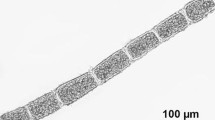Abstract
Cell calcium is accumulated in intracellular stores by sarco-endoplasmic reticulum Ca2+ ATPases functionally interacting with the membrane lipid environment. Cold adaptations of membrane lipids in Antarctic Sea organisms suggest possible adaptive effects also on sarco-endoplasmic reticulum Ca2+ ATPases. We investigated the SR Ca2+ ATPase of an Antarctic scallop, Adamussium colbecki, by characterising the enzyme activity and studying temperature effects. Ca2+ ATPase, assayed by following ATP hydrolysis, was thapsigargin- and vanadate-sensitive, showed maximum activity under 2 μM Ca2+, 200 mM KCl and pH 7.2, and had a K M for ATP of 22 ± 7 μM. Temperature effects showed an Arrhenius inversion between −1.8 and 0°C, indicating cold adaptation, an Arrhenius break at 10°C, and a collapse above 20°C. A. colbecki accumulates high amounts of cadmium in the digestive gland; heavy metal effects on sarco-endoplasmic reticulum Ca2+ ATPases were therefore tested, finding an IC50 = 0.9 μM for Hg2+ and 3 μM for Cd2+. Finally, SDS-PAGE analysis showed a main band at about 100 kDa, which was identified as sarco-endoplasmic reticulum Ca2+ ATPase after trypsin digestion, and accounted for 60% total protein.
Similar content being viewed by others
Author information
Authors and Affiliations
Additional information
Accepted: 10 December 1998
Rights and permissions
About this article
Cite this article
Viarengo, A., Mancinelli, G., Burlando, B. et al. The SR Ca2+ ATPase of the Antarctic scallop Adamussium colbecki: cold adaptation and heavy metal effects. Polar Biol 21, 369–375 (1999). https://doi.org/10.1007/s003000050375
Issue Date:
DOI: https://doi.org/10.1007/s003000050375




